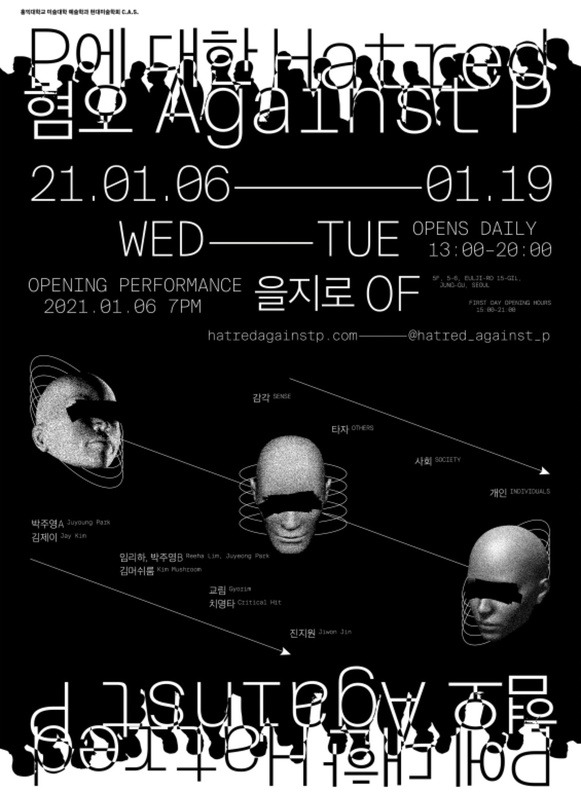
| Period| | 2021.01.06 - 2021.01.19 |
|---|---|
| Operating hours| | Mon-Sun:13:00~20:00 |
| Space| | Euljiro OF/Seoul |
| Address| | 5-6, Eulji-ro 15-gil, Jung-gu, Seoul, Republic of Korea |
| Closed| | mon., tue. |
| Price| | Free |
| Phone| | 010-6532-5231 |
| Web site| | 홈페이지 바로가기 |
| Artist| |
교림,김머쉬룸,김제이,박주영,임리하-박주영b,진지원,치명타
|
정보수정요청



|
|
Exhibition Information
P is a plural, person, and several others, namely anonymous. Depending on what you see, you can place something or someone in this blank space. In the early 20th century, the method of putting anonymity in the title was used to symbolize an unspecified object, a group and an individual. This form also has the nuance of conflict and depression. Hate has been around since accreditation. This is because the instinct to avoid being a threat and harm has made us survive. Therefore, hatred is inevitable. However, the keyword "hate" and the topic of "hate" are unprecedentedly hot potatoes in our society, because in the absence of communication, latent hatred has become visible and discussions and opinions have exploded. This situation has spread faster in conjunction with digital technology, and the heterogeneous hitters of the world are constantly appearing throughout the network. Hate breeds hatred and the topic of hate is no longer in our minds. However, this exhibition is not intended to shed light on hatred. Hate is easily buried because it is a strong emotion in itself. If you search for "hate," the keyword "hate of something" is poured out rather than the definition of it. Even if you ask people about hate without an object in an offline space without anonymity, objects naturally appear in the answer. Another occasional opinion is to combat hatred. Hate is an instinctive emotion that was responsible for survival and cannot be eliminated. In this exhibition, we want to talk about hate itself now that it has become a world of hate. Attempts to designate one's coordinates in an easily swept and intense sea of disgust will be an indicator of the feelings of hatred and accompanying events that will continue to emerge. This exhibition consists of four themes: sense, typewriter, society, and individual, and is organically connected. In the early days, hatred begins with a sense of survival to avoid pollution and disease, which is a sensory abhorrence according to instinct. This primal sense is transferred to the batter through the projection of desire, dirt, and vigilance to keep the self safe from another threat, the outside batter. The transferred aversion naturally permeates into communities with similar properties, and is shared internally and externally in society, extending to various forms. A social outcry eventually returns to the individual within it. It starts in one direction, but it has a circular orientation. In the exhibition, you can see the works of artists that reflect this aspect of disgust.
